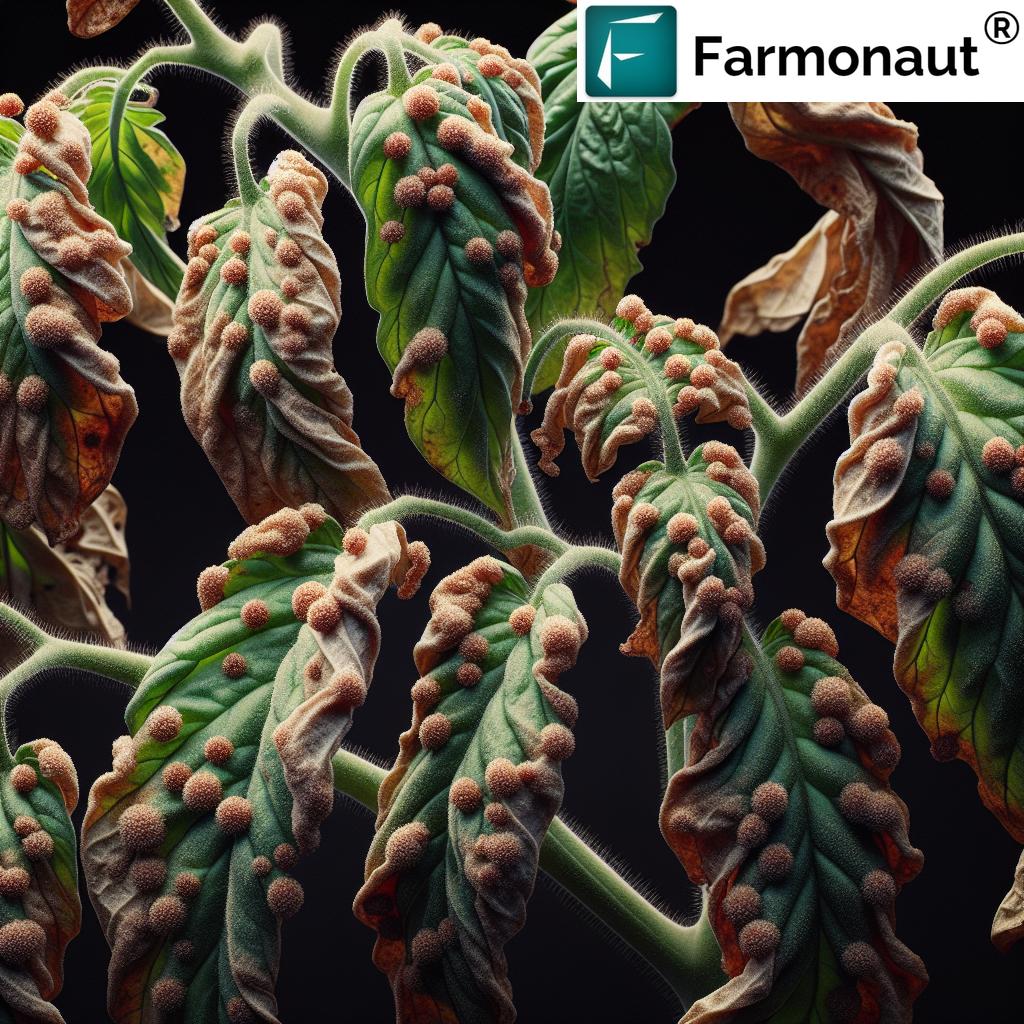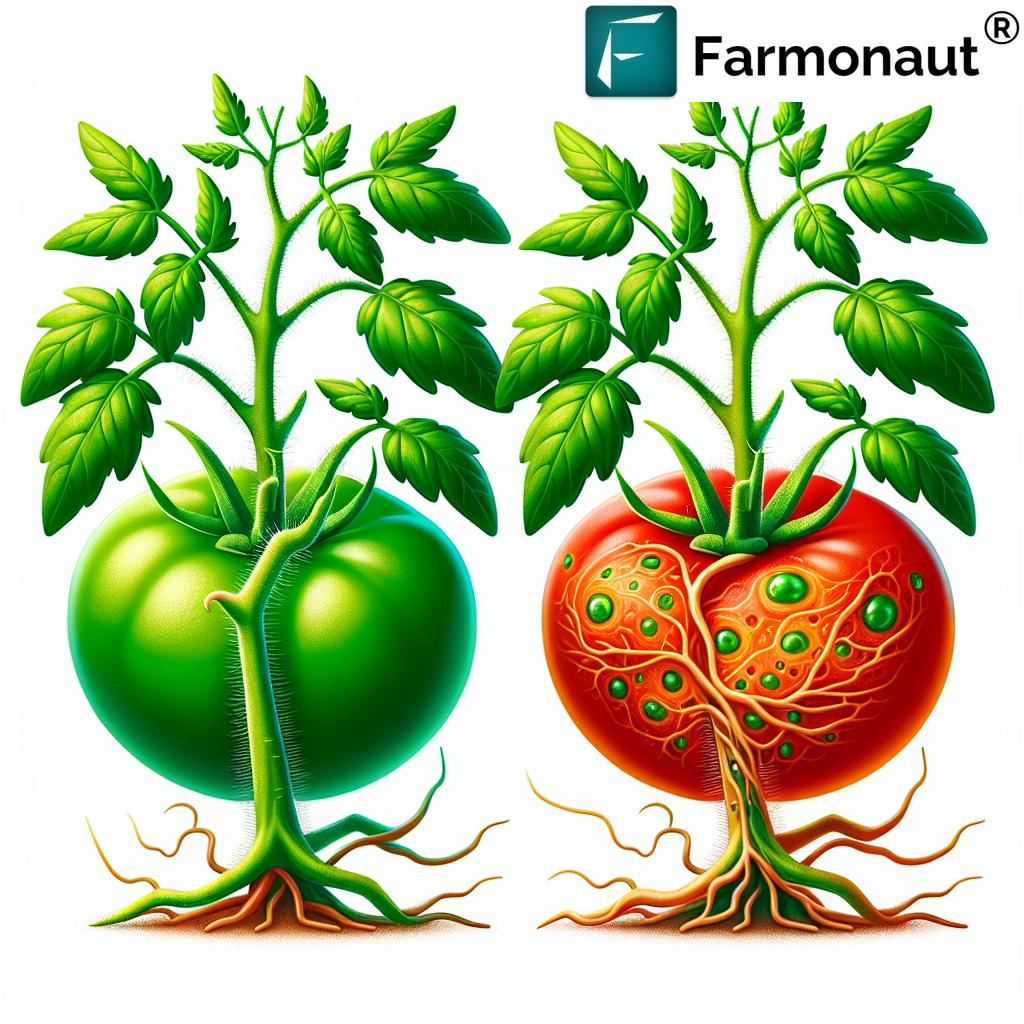Bacterial Canker in Tomatoes: A Comprehensive Guide to Symptoms, Treatment, and Management

In the world of agriculture, tomatoes are a beloved crop grown by farmers and home gardeners alike. However, these delicious fruits are susceptible to various diseases, one of the most destructive being bacterial canker. In this comprehensive guide, we at Farmonaut will delve deep into the intricacies of bacterial canker in tomatoes, exploring its symptoms, treatment options, and management strategies. Our goal is to equip you with the knowledge and tools necessary to protect your tomato crops and ensure a bountiful harvest.
Understanding Bacterial Canker: The Culprit Behind the Disease
Bacterial canker is a serious disease that affects tomato plants, caused by the bacterium Clavibacter michiganensis subsp. michiganensis. This pathogen is particularly troublesome due to its ability to survive in plant debris and soil for extended periods, making it a persistent threat in tomato fields.
The Life Cycle of Clavibacter michiganensis
To effectively manage bacterial canker, it’s crucial to understand the life cycle of its causative agent:
- Survival: The bacterium can survive in soil and plant debris for up to three years.
- Infection: It enters the plant through wounds, natural openings, or during transplanting.
- Colonization: Once inside, it colonizes the vascular system of the plant.
- Spread: The pathogen spreads throughout the plant, causing systemic infection.
- Symptoms: Visible symptoms appear on leaves, stems, and fruits.
- Transmission: The bacteria can spread to other plants through various means, including equipment, insects, and water splashing.
Recognizing the Symptoms: Early Detection is Key
Identifying the symptoms of bacterial canker early is crucial for effective management. Here are the key signs to look out for:
- Leaf Symptoms:
- Wilting of leaflets, often starting on one side of the leaf
- Marginal necrosis (browning) of leaflets
- Interveinal chlorosis (yellowing between leaf veins)
- “Bird’s eye” spots – small, white spots with dark centers on leaves
- Stem Symptoms:
- Dark brown to black lesions on stems
- Stem cankers that may split open
- Discoloration of the vascular tissue when stems are cut lengthwise
- Fruit Symptoms:
- “Bird’s eye” spots on fruits – small, raised white spots with brown centers
- Internal discoloration of fruit
- Plant Symptoms:
- Stunted growth
- Wilting of entire plant, especially in hot weather
- Death of the plant in severe cases

The Host Range: Not Just Tomatoes
While tomatoes are the primary host for Clavibacter michiganensis, it’s important to note that this pathogen can affect other plants in the Solanaceae family. These include:
- Peppers
- Eggplants
- Potatoes
- Some weeds in the nightshade family
Understanding the host range is crucial for implementing effective crop rotation strategies and preventing the spread of the disease to other susceptible crops.
Diagnosis: Confirming Bacterial Canker
Accurate diagnosis is essential for implementing the right management strategies. While the symptoms described above can indicate bacterial canker, they can sometimes be confused with other tomato diseases. Here are some steps for confirming the presence of bacterial canker:
- Visual Inspection: Carefully examine plants for the characteristic symptoms described earlier.
- Stem Cross-Section: Cut an infected stem lengthwise. Look for discoloration in the vascular tissue, which often appears as light brown streaks.
- Laboratory Testing: For definitive diagnosis, send samples to a plant pathology laboratory. They can perform tests to isolate and identify the bacterium.
- PCR Testing: Polymerase Chain Reaction (PCR) tests can detect the presence of Clavibacter michiganensis DNA in plant tissue.
Satellite-Based Detection: The Farmonaut Advantage
At Farmonaut, we leverage advanced satellite technology to revolutionize the way farmers detect and manage diseases like bacterial canker. Our satellite-based crop health monitoring system offers several advantages over traditional detection methods:
| Feature | Traditional Method | Farmonaut Satellite System |
|---|---|---|
| Detection Speed | Slow – Requires manual field inspection | Fast – Real-time satellite imagery analysis |
| Accuracy | Variable – Depends on inspector’s expertise | High – AI-powered analysis of multispectral data |
| Coverage Area | Limited – Time-consuming to cover large areas | Extensive – Can monitor entire fields at once |
| Early Warning | Limited – Often detects disease after visible symptoms appear | Advanced – Can detect stress before visible symptoms |
By utilizing our satellite-based monitoring system, farmers can detect potential disease outbreaks earlier, allowing for more timely and effective interventions. To learn more about how Farmonaut can help protect your tomato crops, visit our app or explore our API services.
Treatment Options: Combating Bacterial Canker
Once bacterial canker is confirmed in your tomato crop, swift action is necessary to minimize its spread and impact. Here are some treatment options to consider:
Chemical Treatments
While there are no chemical treatments that can cure bacterial canker once a plant is infected, some products can help prevent the spread of the disease:
- Copper-based Bactericides: These can be applied as a preventive measure or to slow the spread of the disease. However, they are most effective when used before infection occurs.
- Streptomycin: In some regions, streptomycin sulfate may be approved for use in tomato seedling production to prevent bacterial canker. However, its use is restricted in many areas due to concerns about antibiotic resistance.
Note: Always follow label instructions and local regulations when using chemical treatments.
Organic Treatments
For those preferring organic approaches or in cases where chemical use is restricted, consider these options:
- Biological Control Agents: Some beneficial microorganisms can help suppress the growth of Clavibacter michiganensis. Research is ongoing in this area.
- Plant Extracts: Certain plant-based products, such as neem oil or garlic extracts, may have antimicrobial properties that can help manage the disease.
- Compost Teas: These can boost plant immunity and may help plants resist infection.
Cultural Practices
Often, the most effective treatment for bacterial canker involves cultural practices aimed at preventing and managing the disease:
- Sanitation: Remove and destroy infected plants to prevent the spread of the disease.
- Crop Rotation: Avoid planting tomatoes or other susceptible crops in the same field for at least 3-4 years.
- Clean Seeds and Transplants: Use certified disease-free seeds and transplants.
- Tool Sterilization: Disinfect tools and equipment regularly, especially after working with infected plants.
- Proper Irrigation: Avoid overhead watering, which can spread the bacteria. Use drip irrigation instead.
Prevention: The Best Form of Control
Preventing bacterial canker is far more effective than treating it once it appears. Here are some key strategies for prevention:
1. Seed Selection and Treatment
- Use certified disease-free seeds from reputable suppliers.
- Consider hot water seed treatment (50°C for 25 minutes) to eliminate seed-borne bacteria.
- Treat seeds with approved bactericides before planting.
2. Nursery Management
- Maintain strict hygiene in seedling production areas.
- Use sterile growing media and containers.
- Avoid overhead watering of seedlings.
3. Field Management
- Practice crop rotation with non-host crops.
- Remove and destroy crop debris after harvest.
- Control weeds that may serve as alternative hosts.
- Avoid working in fields when plants are wet.
4. Water Management
- Use drip irrigation or soaker hoses to minimize leaf wetness.
- Ensure proper drainage in fields to prevent waterlogging.
5. Plant Nutrition
- Maintain balanced plant nutrition to promote plant health and resistance.
- Avoid excessive nitrogen, which can increase plant susceptibility.
Integrated Pest Management: A Holistic Approach
Effective control of bacterial canker requires an integrated pest management (IPM) approach. This strategy combines various methods to manage the disease while minimizing environmental impact and preserving beneficial organisms. Key components of an IPM strategy for bacterial canker include:
- Monitoring: Regularly inspect plants for symptoms and use tools like Farmonaut’s satellite monitoring to detect early signs of stress.
- Cultural Controls: Implement the preventive measures discussed earlier, such as crop rotation and sanitation.
- Biological Controls: Utilize beneficial microorganisms that can suppress pathogen growth or boost plant immunity.
- Chemical Controls: Use chemical treatments judiciously and only when necessary, following all safety guidelines and regulations.
- Record Keeping: Maintain detailed records of disease occurrence, treatments applied, and their effectiveness to inform future management decisions.
The Role of Technology in Disease Management
At Farmonaut, we believe that technology plays a crucial role in modern agriculture, especially in disease management. Our satellite-based crop monitoring system offers several advantages for managing bacterial canker and other tomato diseases:
- Early Detection: Our advanced algorithms can detect subtle changes in plant health before visible symptoms appear, allowing for earlier intervention.
- Large-Scale Monitoring: Satellite imagery enables monitoring of large fields quickly and efficiently, something that would be time-consuming and labor-intensive with traditional methods.
- Data-Driven Decision Making: By providing detailed, real-time data on crop health, our system helps farmers make informed decisions about when and where to apply treatments.
- Historical Analysis: Our platform stores historical data, allowing farmers to track disease patterns over time and adjust their management strategies accordingly.
To experience the benefits of our technology firsthand, download our app for Android or iOS.
Case Studies: Learning from Experience
While we don’t provide specific case studies, we can share some general insights from farmers who have successfully managed bacterial canker:
- Early Intervention: Farmers who detected the disease early and took swift action were able to minimize crop losses.
- Integrated Approach: Those who combined cultural, biological, and chemical controls saw better results than those relying on a single method.
- Technology Adoption: Farmers using advanced monitoring tools like satellite imagery reported earlier detection and more targeted treatments.
- Continuous Learning: Successful farmers emphasized the importance of staying informed about the latest research and management techniques.
The Economic Impact of Bacterial Canker
Bacterial canker can have significant economic consequences for tomato growers. The disease can lead to:
- Reduced yields due to plant death or reduced fruit quality
- Increased production costs from disease management efforts
- Potential loss of market access if the disease becomes widespread in a region
By implementing effective prevention and management strategies, growers can minimize these economic impacts and protect their livelihoods.
Research and Future Directions
The fight against bacterial canker is an ongoing effort, with researchers continually working to develop new management strategies. Some promising areas of research include:
- Resistant Varieties: Breeding tomato varieties with increased resistance to Clavibacter michiganensis.
- Biological Control Agents: Identifying and developing new microorganisms that can effectively suppress the pathogen.
- Improved Detection Methods: Developing more sensitive and rapid diagnostic tools for early detection.
- Novel Treatment Options: Exploring new chemicals or biological compounds that can effectively control the disease.
At Farmonaut, we stay abreast of the latest research developments and continuously update our technology to provide farmers with the most effective tools for disease management.
Global Perspective: Bacterial Canker Around the World
Bacterial canker is a global concern, affecting tomato production in many countries. However, its impact and management strategies can vary depending on local conditions:
- North America: Strict regulations on seed production and certification help limit the spread of the disease.
- Europe: Emphasis on integrated pest management and biological control methods.
- Asia: Growing adoption of protected cultivation techniques to manage disease pressure.
- Africa: Focus on developing resistant varieties suitable for local conditions.
- South America: Increasing use of technology for early detection and targeted management.
The Importance of Collaboration
Effective management of bacterial canker requires collaboration among various stakeholders:
- Farmers: Implementing best practices and sharing experiences.
- Researchers: Developing new management strategies and resistant varieties.
- Extension Services: Providing education and support to farmers.
- Technology Providers: Offering tools for monitoring and management.
- Regulatory Bodies: Ensuring safe and effective use of control methods.
At Farmonaut, we strive to foster collaboration by providing a platform that connects farmers with expert advice and cutting-edge technology.
Conclusion: A Holistic Approach to Bacterial Canker Management
Managing bacterial canker in tomatoes requires a comprehensive, integrated approach. By combining cultural practices, chemical treatments when necessary, and advanced monitoring technologies, farmers can effectively prevent and control this destructive disease.
Remember these key points:
- Early detection is crucial for effective management.
- Prevention through good agricultural practices is the best defense.
- Integrate various control methods for the best results.
- Stay informed about the latest research and management techniques.
- Utilize technology like Farmonaut’s satellite monitoring for early detection and targeted management.
By adopting these strategies and leveraging the power of technology, tomato growers can protect their crops, increase yields, and ensure the long-term sustainability of their operations.
FAQ: Bacterial Canker in Tomatoes
- Q: Can bacterial canker affect other crops besides tomatoes?
A: Yes, while tomatoes are the primary host, the pathogen can also affect other plants in the Solanaceae family, including peppers, eggplants, and potatoes. - Q: How long can Clavibacter michiganensis survive in soil?
A: The bacterium can survive in soil and plant debris for up to three years, making crop rotation essential. - Q: Are there any tomato varieties resistant to bacterial canker?
A: While there are no completely resistant varieties, some tomato cultivars show higher tolerance to the disease. Research is ongoing to develop more resistant varieties. - Q: Can bacterial canker be transmitted through seeds?
A: Yes, the pathogen can be seed-borne. Using certified disease-free seeds and treating seeds with hot water or approved chemicals can help prevent transmission. - Q: How effective are copper-based sprays in controlling bacterial canker?
A: Copper-based sprays can be helpful in preventing the spread of the disease, but they are most effective when used preventively before infection occurs. - Q: Can pruning help control bacterial canker?
A: While pruning can help improve air circulation, it should be done carefully as wounds can provide entry points for the bacteria. Always disinfect tools between plants. - Q: Is it safe to compost tomato plants infected with bacterial canker?
A: It’s generally not recommended to compost infected plants, as the pathogen can survive in plant debris. It’s safer to remove and destroy infected plants. - Q: How can Farmonaut’s technology help in managing bacterial canker?
A: Our satellite-based monitoring system can detect early signs of plant stress, allowing for earlier intervention. It also provides comprehensive field data to help target management efforts more effectively. - Q: Are there any biological control methods for bacterial canker?
A: Research is ongoing in this area. Some beneficial microorganisms have shown promise in suppressing the growth of Clavibacter michiganensis, but more studies are needed. - Q: How often should I monitor my tomato plants for bacterial canker?
A: Regular monitoring is crucial. We recommend inspecting plants at least weekly, and more frequently during periods of high disease pressure or after events like heavy rains or hail that can create entry wounds for the bacteria.
For more information on how Farmonaut can help you manage bacterial canker and other crop health issues, visit our website or contact our support team.













